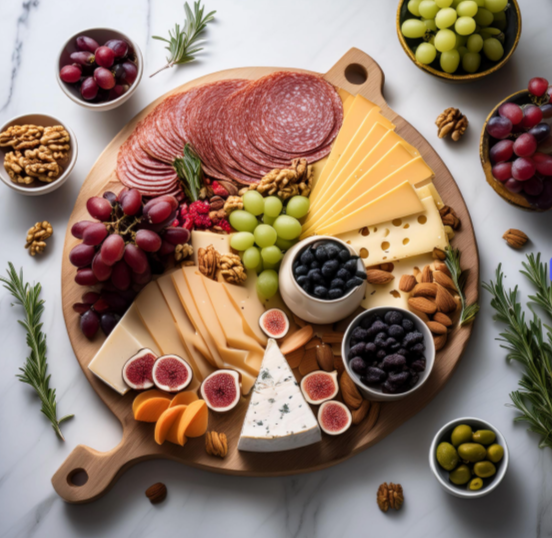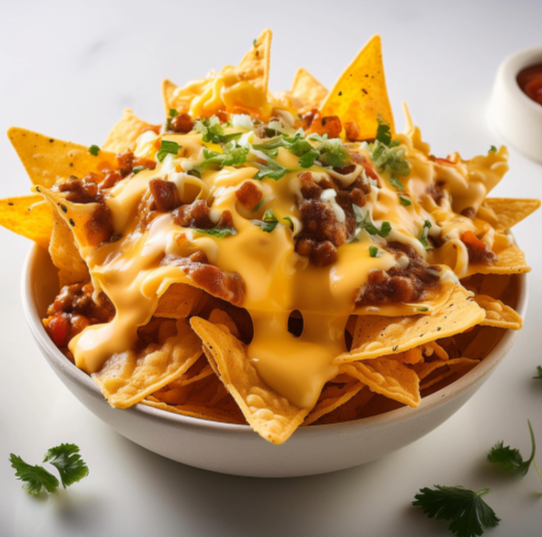
Creating the perfect charcuterie board is an art that combines culinary skills with a keen eye for presentation. Here’s a recipe to guide you step-by-step:
Ingredients:
- Cured Meats: 3-4 types such as salami, prosciutto, and chorizo.
- Cheeses: 3-4 varieties including a soft cheese (brie or camembert), a hard cheese (cheddar or gouda), a blue cheese (stilton or gorgonzola), and a tangy cheese (goat cheese or feta).
- Crackers and Bread: A mix of assorted crackers, breadsticks, and sliced baguette.
- Fruits: A selection of fresh and dried fruits such as grapes, figs, apples, and apricots.
- Nuts: Toasted nuts like almonds, walnuts, and pecans.
- Olives and Pickles: A variety of olives (green, black, stuffed) and pickles or gherkins.
- Spreads: Jams, honey, and mustard for additional flavor.
- Garnishes: Fresh herbs like rosemary or thyme for a finishing touch.
Directions:
- Select a Board: Choose a large wooden or marble board as the base for your presentation.
- Arrange the Cheeses: Place cheeses in different areas of the board to create balance and variety. Slice some pieces for easy grabbing.
- Add the Meats: Artfully fold or roll the cured meats and place them around the cheeses, making sure to separate different types for visual appeal.
- Incorporate Bread and Crackers: Tuck small piles of crackers and slices of bread into gaps, ensuring they are easily reachable.
- Scatter Fresh and Dried Fruits: Add fresh grapes, sliced apples, and dried apricots for pops of color and sweetness.
- Fill with Nuts and Olives: Sprinkle nuts and arrange small bowls or sections of olives and pickles around the board.
- Include Spreads: Place small bowls of jams, honey, and mustard on the board, providing utensils for easy serving.
- Garnish: Add sprigs of fresh herbs to enhance the visual presentation and aroma.
Your perfect charcuterie board is now ready to serve. Enjoy the delightful combinations of flavors, textures, and colors with your guests!

Dessert Charcuterie Board
A dessert charcuterie board is a delightful and innovative way to serve sweets. Much like its savory counterpart, a dessert charcuterie board features a variety of items that satisfy the sweet tooth and create a visually stunning display.
Ingredients:
- Chocolates: Assorted chocolates including dark, milk, white, and truffles.
- Cookies: An assortment of cookies such as shortbread, biscotti, macarons, and chocolate chip.
- Candies: Colorful candies like gummies, marshmallows, and caramels.
- Fruits: Fresh fruits like strawberries, raspberries, grapes, and dried fruits such as apricots and mango slices.
- Nuts: Candied nuts like almonds, pecans, and walnuts.
- Dips and Spreads: Nutella, chocolate sauce, caramel dip, and fruit preserves.
- Cakes and Pastries: Small pieces of brownies, mini cupcakes, eclairs, and tartlets.
- Cheeses: Sweet cheeses like mascarpone, ricotta, and sweetened cream cheese for a luxurious touch.
- Garnishes: Edible flowers, mint leaves, and powdered sugar.
Directions:
- Select a Board: Use a large wooden or marble board as the base for your dessert charcuterie.
- Arrange the Chocolates: Place assorted chocolates in an enticing spread across the board.
- Add the Cookies: Arrange the cookies in small stacks or fans, creating different sections.
- Incorporate Candies: Fill in gaps with different types of candies, adding bursts of color and sweetness.
- Scatter Fresh and Dried Fruits: Place fresh and dried fruits around the board, ensuring a mix of vibrant colors and flavors.
- Include Nuts: Sprinkle candied nuts in small clusters for added crunch and variety.
- Position Dips and Spreads: Place small bowls with Nutella, caramel dip, and fruit preserves, offering utensils for easy serving.
- Add Cakes and Pastries: Arrange small pieces of brownies, mini cupcakes, and other pastries, balancing them across the board.
- Garnish: Finish with edible flowers, mint leaves, and a dusting of powdered sugar for an elegant touch.
Your dessert charcuterie board is now ready to be enjoyed. This sweet spread will undoubtedly impress your guests with its array of flavors, textures, and visual appeal. Enjoy the perfect ending to any meal or celebration!

What Does Charcuterie Mean Literally?
The term “charcuterie” is derived from the French words “chair” (flesh) and “cuit” (cooked). Traditionally, it refers to the culinary art of preparing and assembling cured meats.
What’s the Correct Pronunciation of Charcuterie?
The correct pronunciation of “charcuterie” is “shahr-KOO-tuh-ree”.
What Is the 3-3-3 Rule for Charcuterie Board?
The 3-3-3 rule for a charcuterie board suggests including three types of meats, three types of cheeses, and three types of accompaniments such as nuts, fruits, or spreads.
What Is Typically on a Charcuterie?
A typical charcuterie includes an assortment of cured meats like salami, prosciutto, and chorizo, alongside a variety of cheeses, breads or crackers, and complementary items like olives, nuts, and fresh or dried fruits.
What Is Usually on a Charcuterie Board?
Usually, a charcuterie board features cured meats, a selection of cheeses, crackers or bread, and various accompaniments such as olives, nuts, fruits, and spreads.

What Are 5 Things to Avoid on a Charcuterie Board?
- Avoid Overloading with Carbs: Too many crackers or bread can quickly fill up guests.
- Overly Spicy Meats: Strong flavors might overpower other delicacies on the board.
- Wet Items: Foods that can become soggy, like pickled vegetables, should be limited.
- Highly Aromatic Cheeses: Strong-smelling cheeses can dominate the scents and flavors.
- Mixed Nuts with Shells: Shells can create a mess and aren’t convenient for guests.
How Do You Make a Charcuterie Board Step by Step?
- Start with a Solid Base: Choose a large cutting board or serving platter.
- Place the Cheeses: Arrange soft and hard cheeses around the board, spacing them out.
- Add the Meats: Fold or roll the cured meats and place them near the cheeses.
- Incorporate Crackers and Bread: Tuck them into spaces around the meats and cheeses.
- Fill in with Accompaniments: Add nuts, olives, fruits, and any spreads.
- Garnish: Finish with herbs or edible flowers for a visually appealing touch.
What Are 5 Tips to Making a Charcuterie Board?
- Variety: Include diverse textures and flavors.
- Balance: Mix salty, sweet, and savory items.
- Presentation: Arrange items in an aesthetically pleasing manner.
- Accessibility: Ensure everything can be picked up easily.
- Freshness: Use fresh, high-quality ingredients.
What Should be in a Charcuterie Board?
A charcuterie board should include an assortment of cured meats, a variety of cheeses, a selection of crackers or bread, and accompaniments like nuts, fruits, olives, pickles, and spreads.
What Is Typically on a Charcuterie Plate?
Typically, a charcuterie plate contains cured meats such as ham and salami, cheeses like brie and cheddar, alongside nuts, olives, fresh or dried fruits, and crackers or slices of bread.
What Are the 3 Kinds of Charcuterie?
- Dry-Cured Meats: Such as salami and prosciutto.
- Pâtés and Terrines: Both are types of ground meats, traditionally served cold.
- Smoked Meats: Includes items like smoked ham and bacon.
What Are the Rules of Charcuterie?
The essential rules of charcuterie include balancing flavors and textures, focusing on quality over quantity, and presenting the ingredients in an inviting and accessible manner. Diversity of items and an appealing arrangement are key to a successful charcuterie board.
Is Charcuterie a Meal?
Charcuterie can indeed serve as a complete meal, especially when accompanied by a variety of sides and accompaniments that offer nutritional balance. While traditionally seen as an appetizer or a snack, charcuterie boards can be hearty and filling enough to stand alone as a meal. Including a mix of meats for protein, cheeses for calcium and fats, fruits and vegetables for vitamins, and crackers or bread for carbohydrates ensures a well-rounded offering that satisfies hunger and provides essential nutrients.
How Far in Advance Can You Prepare a Charcuterie Board?
Charcuterie boards can be prepared a few hours in advance to help save time before a gathering. It’s best to keep elements like cheeses covered and meats cold until it’s time to serve, ensuring they stay fresh. Some accompaniments, such as sliced fruits and vegetables, should also be prepared closer to serving time to maintain their crispness and prevent them from drying out or becoming soggy. Proper storage and arrangement can keep your charcuterie board looking and tasting its best when guests arrive.
Where to Buy Olympia Provisions Products
Olympia Provisions is a renowned charcuterie producer known for their high-quality cured meats, sausages, and hot dogs. If you’re wondering where to buy their delectable products, here are some options:
- Olympia Provisions Northwest: Located at 1632 NW Thurman St, Portland, OR, this location offers a selection of Olympia Provisions’ finest meats, including their famous sausages and frankfurters.
- Olympia Provisions SE: Situated at 107 SE Washington St, Portland, OR, this is another great place to purchase their products. This location also features a full restaurant and bar.
- Online Store: You can conveniently order a variety of Olympia Provisions’ meats through their online store on their official website. This includes everything from their popular sausages to their specialty cured meats, shipped directly to your door.
- Local Retailers: Many grocery stores and specialty food shops carry Olympia Provisions products. Check your local stores or use the store locator on their website to find a nearby retailer.
- Farmers Markets: Olympia Provisions often participates in local farmers markets in and around Portland, where you can purchase their fresh products directly.
Enjoy the distinct flavors that Olympia Provisions offers, whether you’re grilling their sausages at a summer BBQ or adding their cured meats to your next charcuterie board. With these options for purchasing their products, you can enjoy the taste of Olympia Provisions anywhere. So why wait? Try out their meats and elevate your charcuterie experience today! Happy snacking!






